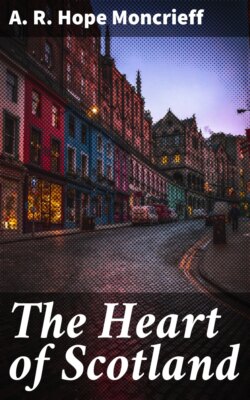Читать книгу The Heart of Scotland - A. R. Hope Moncrieff - Страница 6
На сайте Литреса книга снята с продажи.
ОглавлениеA HIGHLAND STRATH
many-havened coast was the nursery of the Scottish navy and commerce. The most famous national product, next to flesh and blood and whisky, is golf, whose headquarters are in the East Neuk of this choice shire. When we consider the many towns of Fife, its wealth in horn and corn, and coal and fish, its output of textile fabrics, and remember its past history, should we not allow that this and not Perthshire is truly the heart of Scotland? It has even a Wales in Kinross, whose craving for separate status might one day raise a troublesome question. Nor does it want a classic bard to invoke for it the trumpet of fame:
Nymphae, quae colitis highissima monta Fifaea,
Seu vos Pittenwema tenent, seu Cralia crofta,
Sive Anstraea domus, ubi nat haddocus in undis,
Codlineusque ingens, et fleucca et sketta pererrant
Per costam, et scopulis lobster monifootus in udis
Creepat, et in mediis ludit whitenius undis, etc.
Gentle reader, can you guess what standard poet I quote? Je vous le donne en cent. The most hackneyed citation, it seems, ought nowadays to be labelled, for when in Bonnie Scotland I aired a verse beginning, “Fairshon had a son who married Noah’s daughter,” a certain Caledonian newspaper critic was moved to applaud by calling for the author. Such be the proficient patriots who scunner at King Edward’s title as Seventh across the Tweed, and at other bawbeeworths of offence to Scottish nationality!
After this fling by the way, I fall back into my jogtrot. It seems claimable for Fife, then, that its county council be glorified as a parliament sitting by turns at Cupar, Dunfermline, and Kirkcaldy; or, at least, that in a revived Scottish parliament its representatives shall assert their old privilege of voting first, before that presumptuous Perthshire. The sovereign’s title raises some difficulty. Edward VII., of course, is out of the question. But it has to be admitted that Edward I. of England received the homage of Fife at Dunfermline, so his present Majesty might justly be styled Edward II. qua King of Fife. There being, indeed, a doubt as to how far Edward Baliol made his reign a fait accompli in Fife, some precisians propose to meet the case by treating our king locally as the second and a half Edward. In the army, of course, it is not to be borne that the Fife contingent shall be lumped together with English forces. In future, one or more British regiments must be equipped and distinguished as Fifers. The epithet Fifeish should come into more constant use; but as misconception might arise from vulgar misuse, Fifeian may be coined as an untarnished adjective, the old one to be applied to the less admirable or more commonplace features of the county, its distilleries, railway junctions, colliery villages, east winds, and so forth, while a discrimination is to be made in quoting those qualities and achievements that have made Fife the noblest member of the greatest empire in the world, whose style shall forthwith run, at least in local acts, The Kingdom of Fife, with the adjacent kingdoms of Scotland, England, and Ireland, and the rest of the British dominions, etc., etc.
For Perthshire, I make no such pretensions to isolated dignity, only for having set a pattern to all Scotland, and thus exhibiting some title to be taken as hub of the universe. But in rambling over its hills and glens, I hope to let it show for itself the truth of Scott’s estimate, justified by his reference to other writers, such as might be quoted by the hundred, all in the same tale of due admiration.
It is long since Lady Mary Wortley Montagu, with that excellent taste which characterises her writings, expressed her opinion that the most interesting district of every country, and that which exhibits the varied beauties of natural scenery in greatest perfection, is that where the mountains sink down upon the champaign, or more level land. The most picturesque, if not the highest hills, are also to be found in the county of Perth. The rivers find their way out of the mountainous region by the wildest leaps, and through the most romantic passes connecting the Highlands with the Lowlands. Above, the vegetation of a happier climate and soil is mingled with the magnificent characteristics of mountain-scenery; and woods, groves, and thickets in profusion, clothe the base of the hills, ascend up the ravines, and mingle with the precipices. It is in such favoured regions that the traveller finds what the poet Gray, or some one else, has termed, Beauty lying in the lap of Terror.
